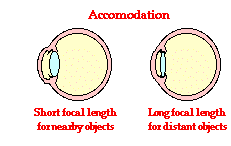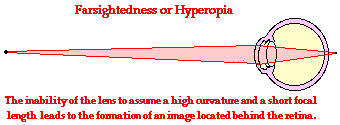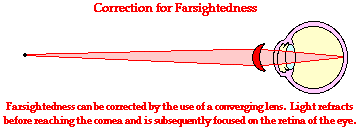Hold down the T key for 3 seconds to activate the audio accessibility mode, at which point you can click the K key to pause and resume audio. Useful for the Check Your Understanding and See Answers.
The human eye's ability to accommodate allows it to view focused images of both nearby and distant objects. As  mentioned earlier in Lesson 6, the lens of the eye assumes a large curvature (short focal length) to bring nearby objects into focus and a flatter shape (long focal length) to bring a distant object into focus. Unfortunately, the eye's inability to a provide a wide variance in focal length leads to a variety of vision defects. Most often, the defect occurs at one end of the spectrum - either the inability to assume a short focal length and focus on nearby objects or the inability to assume a long focal length and thus focus on distant objects.
mentioned earlier in Lesson 6, the lens of the eye assumes a large curvature (short focal length) to bring nearby objects into focus and a flatter shape (long focal length) to bring a distant object into focus. Unfortunately, the eye's inability to a provide a wide variance in focal length leads to a variety of vision defects. Most often, the defect occurs at one end of the spectrum - either the inability to assume a short focal length and focus on nearby objects or the inability to assume a long focal length and thus focus on distant objects.
Farsightedness or hyperopia is the inability of the eye to focus on nearby objects. The farsighted eye has no difficulty viewing distant objects. But the ability to view nearby objects requires a different lens shape - a shape that the farsighted eye is unable to assume. Subsequently, the farsighted eye is unable to focus on nearby objects. The problem most frequently arises during latter stages in life, as a result of the weakening of the ciliary muscles and/or the decreased flexibility of the lens. These two potential causes leads to the result that the lens of the eye can no longer assume the high curvature that is required to view nearby objects. The lens' power to refract light has diminished and the images of nearby objects are focused at a location behind the retina. On the retinal surface, where the light-detecting nerve cells are located, the image is not focused. These nerve cells thus detect a blurry image of nearby objects.

Correcting for Farsightedness
The cure for the farsighted eye centers around assisting the lens in refracting the light. Since the lens can no longer assume the convex and highly curved shape that is required to view nearby objects, it needs some help. Thus, the farsighted eye is assisted by the use of a converging lens. This converging lens will refract light before it enters the eye and subsequently decreases the image distance. By beginning the refraction process prior to light reaching the eye, the image of nearby objects is once again focused upon the retinal surface.

While farsightedness most often occurs among adults, occasionally younger people will suffer from this vision defect. When farsightedness occurs among youth, the cause is seldom related to the inability of the lens to assume a short focal length. In this case, the problem is more closely related to an eyeball that is shortened. Because the eyeball is shortened, the retina lies closer than usual to the cornea and lens. As a result, the image of nearby objects is formed beyond the retina. The traditional correction for such a problem is the same as for adults - the use of a converging lens.